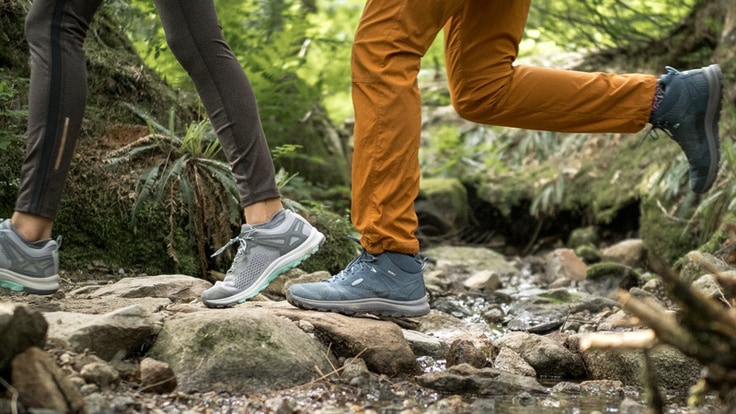Newbie hikers or those looking to replace an older pair of hiking boots often ask the question these days: Do I have to buy a pair of burly boots to hike in the woods or go backpacking? Of course not. After all, there are people who thru-hike the Appalachian Trail (AT) in their bare feet.
If you asked the boot question, though, you were probably wondering: Would a pair of trail runners be an acceptable alternative—or an even better choice than a pair of heavy hiking boots? We asked footwear guru Beth Henkes in our REI Alderwood store in Washington to tell us how she helps customers decide between boots and shoes. The simple answer is that both hiking boots and trail runners will get you out on the trail, but where, when and how you hike may impact your choice.
Henkes confesses customers today seem to have a thing for trail runners. Some are obsessed with their light weight; others love how comfortable they feel right out of the box, while the more fashion conscious might prefer the wide range of designs and colors. No one choice is right for all, though, and boots still have much to offer.
Video: Boots vs. Trail Runners
Here are the key questions for choosing between boots and trail runners:
- New to hiking? Keeping yourself upright on trails while wearing a pack takes a while to master. The wide, thick soles on hiking boots will provide a stable base for every footfall.
- What's the terrain on your trail? Sketchy trails require beefier boots for both stability and the ability to stand up to wear and tear. And their stout soles can handle abuse from rocks and roots, so your feet don't have to. If it's a beautiful, meandering forest trail, though, light and lean footwear will work fine. If it's a paved nature trail, even a pair of city sneakers can handle it. If you expect to hike in cold, wet conditions, you might prefer the warmth and protection of a sturdy boot with a waterproof membrane, but you can find waterproof trail-running shoes as well.
- What's your body type? You likely already have a sense of whether your body requires more support from your footwear in general. If it does, and you plan to add a heavy pack to your overall weight, a solid, stable hiking boot may be your best choice. If you haven't had any previous issues with strength and stability of your legs and joints and you're not planning to carry a significantly heavy load, you're probably a good trail-runner candidate.
- How fast will you be going? Is it a slow and steady sojourn or a speed hike? Lightweight trail runners make it easier to maintain a brisk pace. That's why many thru-hikers wear them, because they need to knock off huge chunks of miles, day after day. Of course, on a trail as long as the AT they'll go through several pairs of trail runners.
Comparing Traction
Hiking boots generally have thick lugs to bite into soil and a rubber that grips well on a variety of surfaces. Light trail runners offer minimal grip, but rugged and off-trail styles offer similar traction to hiking shoes. Some trail runners also feature a sticky rubber compound for enhanced grip on wet rocks and logs.
Be aware, though, says Henkes, that many trail runners are actually designed to grip on the fly and they won't have the same level of traction at a slower hiking pace. The physics change when you apply less force on each stride.
Decision Matrix: Hiking Boots vs. Trail Runners
Still not sure? Here's a quick and dirty comparison to help you choose between hiking boots vs. trail runners:
Hiking Boots - Key Benefits | Trail Runners - Key Benefits |
|---|---|
Stability | Breathability, so feet stay drier |
Durability | Little or no break-in period |
Foot and ankle protection | Lightweight for a fast pace, long miles |
Slough off mud, snow and water | Versatile for multiple uses |
Warmer for cold-weather hikes | Cooler for hot-weather hikes |
Good all-around traction | A range of traction options |
Hiking Boots - Key Downsides | Trail Runners - Key Downsides |
|---|---|
Heavier and bulkier | Less supportive |
Require break-in period | Will need replacing more often |
Maybe It's Not an Either/Or Question
With literally hundreds of hiking boots, as well as hundreds of trail-running shoes to choose from, you'll find a continuum of choices in each category. If you want a light, breathable option that offers excellent stability and ankle protection, you can get some lightweight day-hiking boots with mesh uppers. Or you could opt for high-top, off-trail-style trail runners.
To help you navigate through all of those choices, start by reading How to Choose Hiking Boots and How to Choose Trail Runners. Then, because the right choice also involves getting the right fit, your next stop should be an outdoor specialty store like REI.
